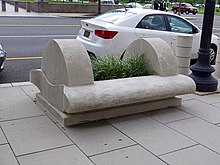Hostile vehicle mitigation

Hostile vehicle mitigation (HVM) is a generic term that covers a suite of anti-terrorist protective measures that are often employed around buildings or publicly accessible spaces/venues of particular significance.[1][2] The design of these various vehicle security barriers and landscape treatments came about as security authorities across the globe sought to mitigate the effects of vehicle borne improvised explosive devices (VBIED)[3] and vehicle-ramming attacks. The sorts of places that warrant consideration as potential terrorist targets in need of HVM include: government buildings, airports, large railway stations, sports venues, concentrations of entertainment and crowded night time economy, etc.[4][5]
Usage
Common types of HVM include locally manufactured barrier systems such as the Jersey Barrier and Bremer T Wall; as well as proprietary crash-tested and engineered vehicle bollard systems designed to resist the effects of a vehicle ram attack.[6] HVM can also include adapted hard landscape features, resistive street furniture, sculpture, planters and significant level changes; with a little imagination HVM may be disguised inside architectural features in a street scene.[7][8]
HVM when installed and fixed correctly is designed to resist hostile vehicle penetration of certain categories of vehicle moving at a range of speeds,[9] these vehicle security barriers undergo various destructive tests carried out by accredited test establishments.[10][11] The three standards that are generally quoted when specifying HVM performance are:
- ISO IWA 14-1 - an international working agreement[12]
- BSI PAS 68 - the UK standard[13]
- ASTM F2656-07 - the US standard.[14]
These standards set roughly similar criteria for destructive impact testing, although there are differences between the three and vehicle geometries in particular are at the root of some of these differences. HVM barrier selection will be conditioned by a hostile vehicle dynamics study carried out by a suitably qualified security specialist.[15]



Ideally a protective layer of HVM should surround the building or place being protected and this HVM protection line should be stood off from the building facade or places expected to be crowded. This protective standoff distance is critical in the case of VBIEDs as 'every metre counts' and often distance is one of the best ways to achieve explosive blast effects mitigation.[16][17]

More recently the focus of HVM has expanded to reduce the potential for vehicle ram attacks directed at crowded events and places.[18] Recent non-VBIED (i.e. vehicle as a weapon) attacks against pedestrians include:
- The 2016 Nice truck attack
- The 2016 Ohio State University attack
- The 2016 Berlin truck attack
- The 2017 Jerusalem attack
- The January 2017 Melbourne car attack
- The 2017 Sandy, Utah attack
- The 2017 Stockholm truck attack
- The 2017 Westminster attack
- The 2017 London Bridge attack
- The 2017 Finsbury Park attack
- The 2025 New Orleans truck attack
HVM can also be used to protect against ram raids which are invariably criminal attacks against high net-worth targets such as jewelers, cash and valuables in transit depots, bullion storage facilities, art galleries, museums, high-end fashion stores, etc.[19]
Correctly installed HVM barrier systems should not adversely affect pedestrian permeability.[20]
See also
- Deaths by car bomb
- Improvised explosive device (IED)
- List of mass car bombings
- Vehicle-ramming attack
- Counter-terrorism
- Security
- Physical security
References
- ^ "Hostile vehicle mitigation | Public Website". www.cpni.gov.uk. Retrieved 3 July 2017.
- ^ "Reference Manual to Mitigate Potential Terrorist Attacks Against Buildings" (PDF). Retrieved 3 July 2017.
- ^ Cormie, David; Mays, Geoff; Smith, Peter (2009). Blast effects on buildings (PDF) (2nd ed.). London: Thomas Telford Ltd. pp. 250–273. ISBN 978-0-7277-3521-8. Retrieved 3 July 2017.
- ^ "Crowded Places Guidance" (PDF). NaCTSO. Retrieved 3 July 2017.
- ^ Aston, Heath (13 April 2016). "Terror guidelines urge blast mitigation measures for busy public areas". The Sydney Morning Herald. Retrieved 3 July 2017.
- ^ "Vehicle security barriers within the streetscape (TAL 01/11) - GOV.UK". www.gov.uk. UK Government. Retrieved 28 September 2017.
- ^ "Integrated Security - a Public Realm Design Guide for Hostile Vehicle Mitigation - Second Edition" (PDF). CPNI. Retrieved 3 July 2017.
- ^ McPhee, Rod (24 March 2017). "Latest weapon against terrorism appearing all over UK but you won't have noticed". UK Daily Mirror. Mirror Newspapers. Retrieved 3 July 2017.
- ^ "Guide to Active Vehicle Barrier (AVB) Specification and Selection Resources" (PDF). US Government. Retrieved 3 July 2017.
- ^ "Traffic Advisory Leaflet 1/11" (PDF). Retrieved 3 July 2017.
- ^ "Hostile vehicle attacks - how do we make places safer? - Foundations". Foundations. 20 June 2017. Retrieved 3 July 2017.
- ^ "IWA 14-1:2013 - Vehicle security barriers -- Part 1: Performance requirement, vehicle impact test method and performance rating". www.iso.org. Retrieved 3 July 2017.
- ^ "PAS 68:2013 - Impact test specifications for vehicle security barrier systems". shop.bsigroup.com. Retrieved 3 July 2017.
- ^ "ASTM F2656 / F2656M - 15 Standard Test Method for Crash Testing of Vehicle Security Barriers". www.astm.org. Retrieved 3 July 2017.
- ^ "Recognising the terrorist threat". www.gov.uk. Retrieved 3 July 2017.
- ^ "IMPROVISED EXPLOSIVE DEVICE (IED) GUIDELINES FOR PLACES OF MASS GATHERING" (PDF). ANZCTC. Retrieved 3 July 2017.
- ^ "FEMA 426, Chapter 4" (PDF). US Government. Retrieved 3 July 2017.
- ^ "Protecting Crowded Places: Design and Technical Issues" (PDF). HM Government. Retrieved 3 July 2017.
- ^ Louks, Dominic. "S10 - Guidance for protection of premises against vehicle attack (ram raid)". www.riscauthority.co.uk. Retrieved 3 July 2017.
- ^ "Bollards and Pedestrian Movement, TAL 2/13" (PDF). HM Government. Retrieved 4 July 2017.
